engine TOYOTA TUNDRA 2021 (in English) User Guide
[x] Cancel search | Manufacturer: TOYOTA, Model Year: 2021, Model line: TUNDRA, Model: TOYOTA TUNDRA 2021Pages: 52, PDF Size: 3.8 MB
Page 16 of 52
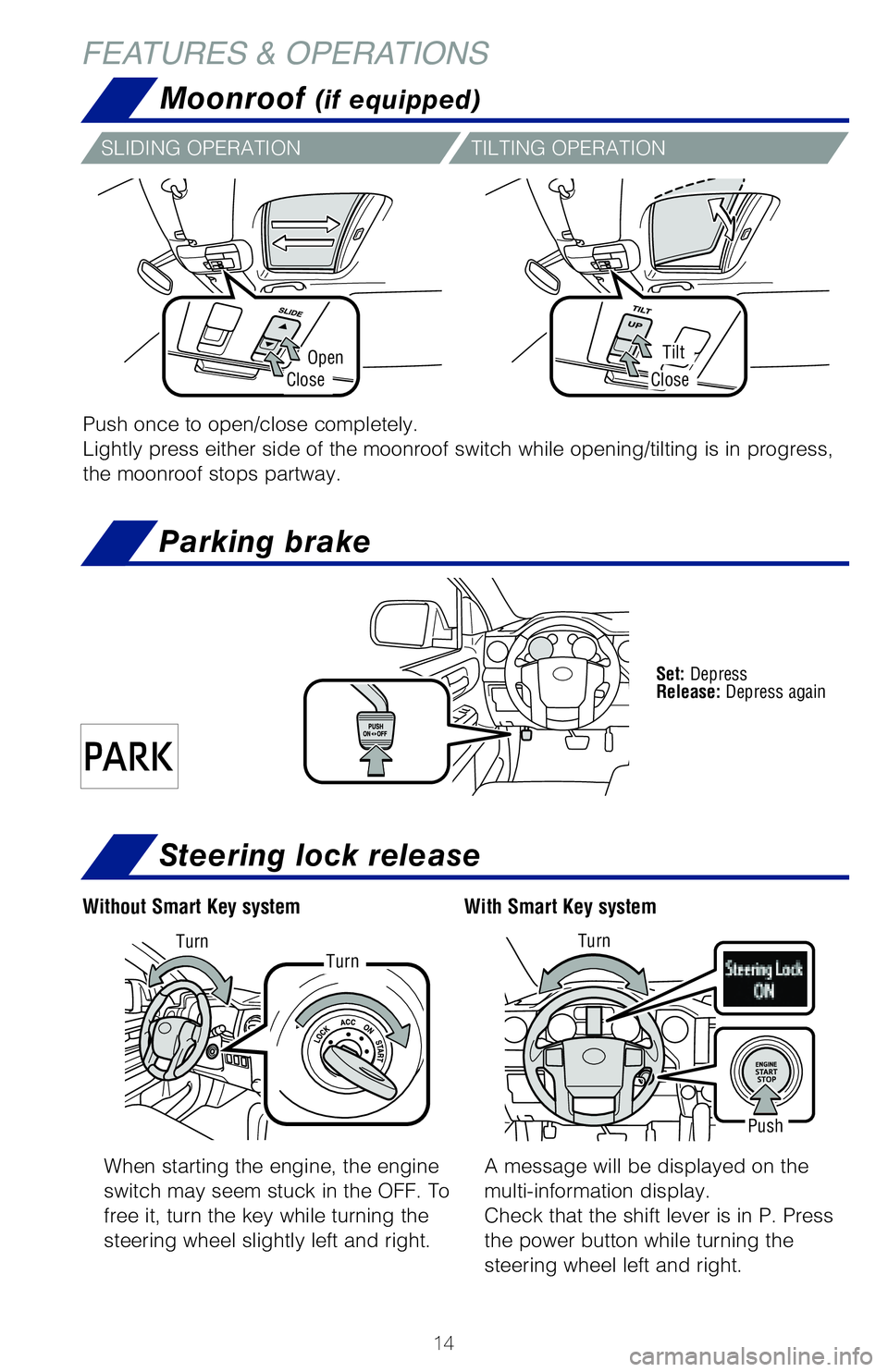
14
FEATURES & OPERATIONSMoonroof
(if equipped)
OpenTilt
CloseClose
Push once to open/close completely.
Lightly press either side of the moonroof switch while opening/tilting i\
s in progress,
the moonroof stops partway.
SLIDING OPERATION TILTING OPERATION
All window up/down (passenger side for some models and driver side) Push
the switch completely down or pull it completely up and release to fully\
open or
close.* To stop window part way, lightly push the switch in the opposite\
direction.
Window lock switch Deactivates all passenger windows. Driver’s window remains
operable.
* Not all models are equipped with one-touch close function.
Driver side (Type A)
Window lock switch
Set: Depress
Release: Depress again
Parking brake
Steering lock release
When starting the engine, the engine
switch may seem stuck in the OFF. To
free it, turn the key while turning the
steering wheel slightly left and right. A message will be displayed on the
multi-information display.
Check that the shift lever is in P. Press
the power button while turning the
steering wheel left and right.
With Smart Key system
Without Smart Key system
Push
Turn
Turn
Turn
MY21_Tundra_QRG_V2_ML_0709.indd 147/13/20 10:54 AM
Page 26 of 52
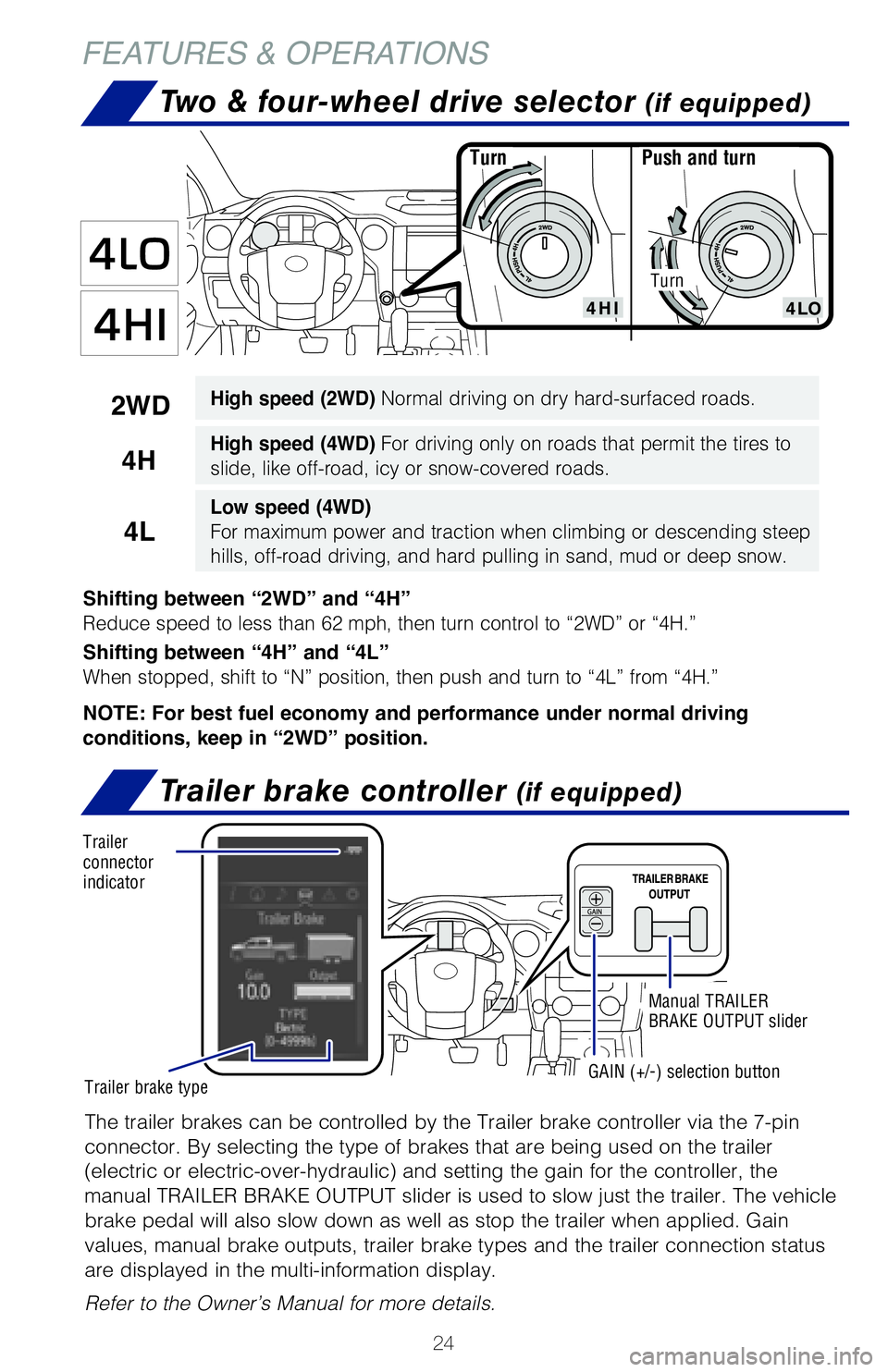
24
FEATURES & OPERATIONS
Push and turnTurn
Shifting between “2WD” and “4H”
Reduce speed to less than 62 mph, then turn control to “2WD” or “\
4H.”
Shifting between “4H” and “4L”
When stopped, shift to “N” position, then push and turn to “4L”\
from “4H.”
NOTE: For best fuel economy and performance under normal driving
conditions, keep in “2WD” position.
2WDHigh speed (2WD) Normal driving on dry hard-surfaced roads.
4HHigh speed (4WD) For driving only on roads that permit the tires to
slide, like off-road, icy or snow-covered roads.
4L
Low speed (4WD)
For maximum power and traction when climbing or descending steep
hills, off-road driving, and hard pulling in sand, mud or deep snow.
Turn
Two & four-wheel drive selector (if equipped)
The trailer brakes can be controlled by the Trailer brake controller via\
the 7-pin
connector. By selecting the type of brakes that are being used on the tr\
ailer
(electric or electric-over-hydraulic) and setting the gain for the con\
troller, the
manual TRAILER BRAKE OUTPUT slider is used to slow just the trailer. The\
vehicle
brake pedal will also slow down as well as stop the trailer when applied\
. Gain
values, manual brake outputs, trailer brake types and the trailer connec\
tion status
are displayed in the multi-information display.
Refer to the Owner’s Manual for more details.
“Tow/Haul” mode is ideal for use when carrying heavy loads. When t\
he TOW/HAUL
switch is pressed, throttle response and transmission control are optimi\
zed for the
high performance operation. As fuel economy is reduced while in “Tow/\
Haul” mode,
deactivating when driving without a load is recommended.
• Upshifts occur at higher engine speeds to expand the use of lower g\
ear ranges, enhancing power performance during towing and preventing repeated gear
changes.
• Downshifts occur at a greater accelerator pedal angle to allow the vehic\
le to stay
in a higher gear, reducing repeated gear changes.
• Downshifts occur at a lower accelerator pedal angle to allow the vehicle\
to stay in
a lower gear, enhancing towing ability.
• When the accelerator pedal is wide open, upshift timing is optimized to \
effectively
use the maximum engine power range available.
When Tow/Haul is engaged, the opening angle of the electronically contro\
lled
throttle is wider for any given accelerator pedal position than normal, \
enhancing
acceleration feeling and response.
• During uphill driving, the gear position is held to prevent repeated ups\
hifting.
• During downhill driving, downshifting to lower gears will occur to effec\
tively use
engine braking.
Refer to the Owner’s Manual for more details on this system before at\
tempting to
use it.
Floor shift type
Trailer brake controller (if equipped)
ENGINE CONTROL
ENHANCED SHIFT CONTROL
UPHILL/DOWNHILL SHIFT FEATURES
Manual TRAILER
BRAKE OUTPUT slider
Trailer
connector
indicator
Trailer brake type
GAIN (+/-) selection button
MY21_Tundra_QRG_V2_ML_0709.indd 247/13/20 10:54 AM
Page 27 of 52

25
Shifting between “2WD” and “4H”
Reduce speed to less than 62 mph, then turn control to “2WD” or “\
4H.”
Shifting between “4H” and “4L”
When stopped, shift to “N” position, then push and turn to “4L”\
from “4H.”
NOTE: For best fuel economy and performance under normal driving
conditions, keep in “2WD” position.
High speed (2WD) Normal driving on dry hard-surfaced roads.
High speed (4WD) For driving only on roads that permit the tires to
slide, like off-road, icy or snow-covered roads.
Low speed (4WD)
For maximum power and traction when climbing or descending steep
hills, off-road driving, and hard pulling in sand, mud or deep snow.
Two & four-wheel drive selector (if equipped)
The trailer brakes can be controlled by the Trailer brake controller via\
the 7-pin
connector. By selecting the type of brakes that are being used on the tr\
ailer
(electric or electric-over-hydraulic) and setting the gain for the con\
troller, the
manual TRAILER BRAKE OUTPUT slider is used to slow just the trailer. The\
vehicle
brake pedal will also slow down as well as stop the trailer when applied\
. Gain
values, manual brake outputs, trailer brake types and the trailer connec\
tion status
are displayed in the multi-information display.
Refer to the Owner’s Manual for more details.
TOW/HAUL switch (if equipped)
“Tow/Haul” mode is ideal for use when carrying heavy loads. When t\
he TOW/HAUL
switch is pressed, throttle response and transmission control are optimi\
zed for the
high performance operation. As fuel economy is reduced while in “Tow/\
Haul” mode,
deactivating when driving without a load is recommended.
• Upshifts occur at higher engine speeds to expand the use of lower g\
ear ranges, enhancing power performance during towing and preventing repeated gear
changes.
• Downshifts occur at a greater accelerator pedal angle to allow the vehic\
le to stay
in a higher gear, reducing repeated gear changes.
• Downshifts occur at a lower accelerator pedal angle to allow the vehicle\
to stay in
a lower gear, enhancing towing ability.
• When the accelerator pedal is wide open, upshift timing is optimized to \
effectively
use the maximum engine power range available.
When Tow/Haul is engaged, the opening angle of the electronically contro\
lled
throttle is wider for any given accelerator pedal position than normal, \
enhancing
acceleration feeling and response.
•
During uphill driving, the gear position is held to prevent repeated ups\
hifting.
• During downhill driving, downshifting to lower gears will occur to effec\
tively use
engine braking.
Refer to the Owner’s Manual for more details on this system before at\
tempting to
use it.
Floor shift type
System ON/OFF
System ON/OFF
Column shift type
ENGINE CONTROL
ENHANCED SHIFT CONTROL
UPHILL/DOWNHILL SHIFT FEATURES
OVERVIEW
FEATURES & OPERATIONS
TOYOTA SAFETY SENSE
SAFETY & EMERGENCY FEATURES
Manual TRAILER
BRAKE OUTPUT slider
MY21_Tundra_QRG_V2_ML_0709.indd 257/13/20 10:54 AM
Page 40 of 52

38
TOYOTA SAFETY SENSE™
ADJUSTING DISTANCE
To change the vehicle-to-vehicle
distance
Push the “
” button to
cycle through the settings,
which will change progressively.
This mode employs a radar sensor to detect the presence of a preceding v\
ehicle
up to approximately 328 ft (100 m) ahead, determines the current vehic\
le-to-vehicle
following distance and operates to maintain a preset following distance \
from the
vehicle ahead. These distances vary based on vehicle speed.
(1) (2) (3)
(1) Constant speed cruising when there are no vehicles ahead
The vehicle travels at the speed set by the driver. The desired vehicle-\
to-
vehicle distance can also be set by operating the vehicle-to-vehicle dis\
tance
control.
(2) Deceleration cruising and follow-up cruising when a preceding vehicle
driving slower than the set speed appears When a vehicle is detected running ahead of you, the system automaticall\
y
decelerates your vehicle. When a greater reduction in vehicle speed is
necessary, the system applies the brakes (the brake lights will come on\
at this
time). The system will respond to changes in the speed of the vehicle a\
head
in order to maintain the vehicle-to-vehicle distance set by the driver. \
A warning
tone warns you when the system cannot decelerate sufficiently to prevent\
your
vehicle from closing in on the vehicle ahead.
Note: Vehicle-to-vehicle distance will close in when traveling on long downhill
slopes.
Preceding
vehicle mark LONG
(default setting) MIDDLE SHORT
SETTING CONSTANT SPEED (CRUISE) CONTROL
SWITCHING TO CONSTANT SPEED (CRUISE) CONTROL MODE
Note: When your vehicle is too close to a vehicle ahead, and sufficient automatic
deceleration via the cruise control is not possible, the display will flash and the
buzzer will sound to alert the driver. An example of this would be if another driver
cuts in front of you while you are following a vehicle. Depress the brake pedal to
ensure an appropriate vehicle-to-vehicle distance.
If you are already using DRCC “,” push button again to turn the system off
first, then push and hold button for at least 1.5 seconds to switch.
Note: When the engine is turned off, it will automatically default to DRCC.
(3) Acceleration when there are no longer any preceding vehicles driving
slower than the set speed The system accelerates until the set speed is reached. The system then
returns to constant speed cruising.
DRCC ADJUSTING DISTANCE (CONTINUED)
To adjust speed or cancel, see steps (2) and (3) of ADJUSTING SET SPEED on
page 37.
Refer to the Toyota Owner’s Manual for additional information on DRCC\
operation,
settings adjustments, limitations, and precautions before attempting to \
use it.
MY21_Tundra_QRG_V2_ML_0709.indd 387/13/20 10:54 AM
Page 41 of 52
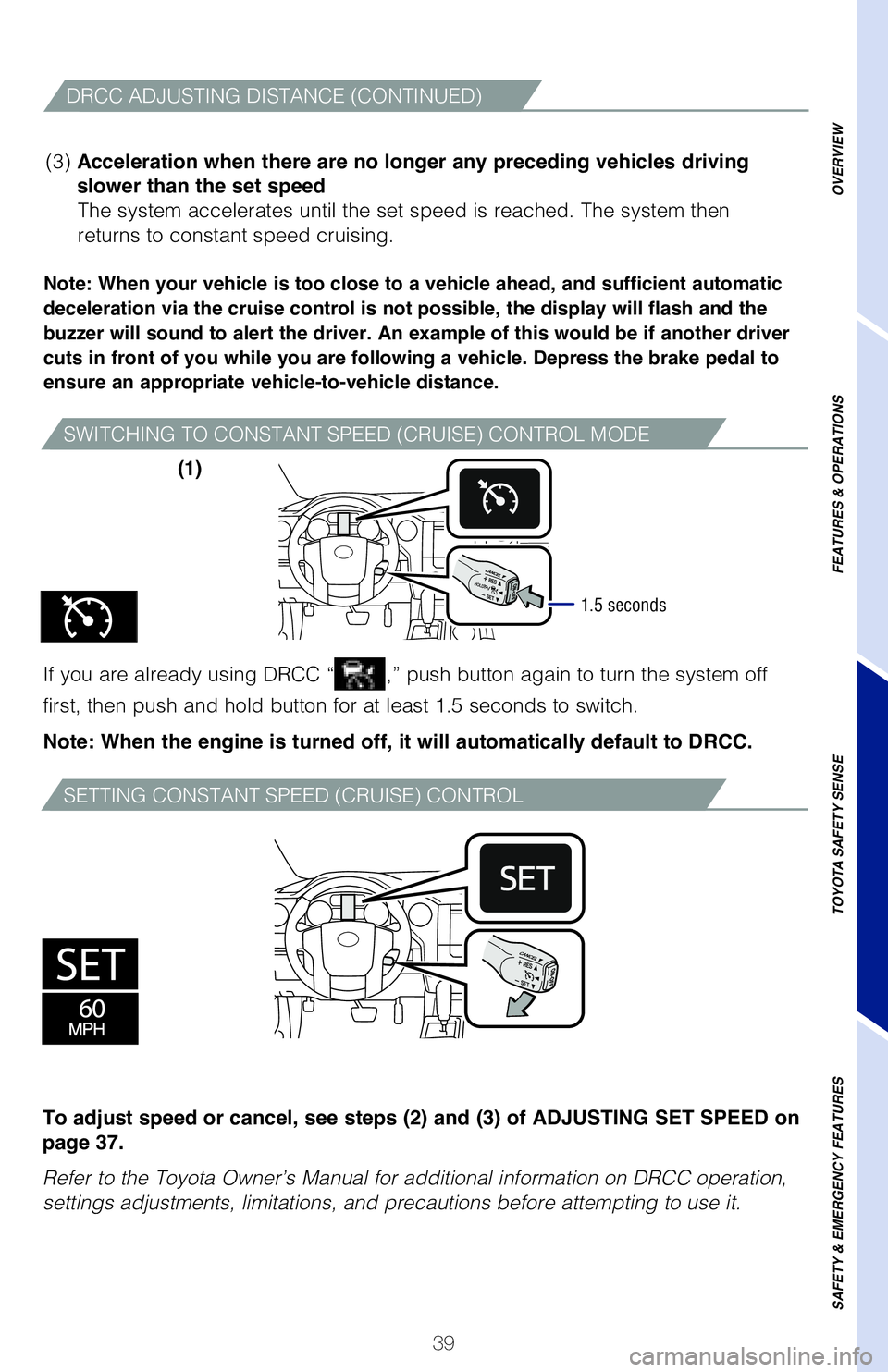
39
To change the vehicle-to-vehicle
distance
Push the “
” button to
cycle through the settings,
which will change progressively.
This mode employs a radar sensor to detect the presence of a preceding v\
ehicle
up to approximately 328 ft (100 m) ahead, determines the current vehic\
le-to-vehicle
following distance and operates to maintain a preset following distance \
from the
vehicle ahead. These distances vary based on vehicle speed.
(1) Constant speed cruising when there are no vehicles ahead
The vehicle travels at the speed set by the driver. The desired vehicle-\
to-
vehicle distance can also be set by operating the vehicle-to-vehicle dis\
tance
control.
(2) Deceleration cruising and follow-up cruising when a preceding vehicle
driving slower than the set speed appears
When a vehicle is detected running ahead of you, the system automaticall\
y
decelerates your vehicle. When a greater reduction in vehicle speed is
necessary, the system applies the brakes (the brake lights will come on\
at this
time). The system will respond to changes in the speed of the vehicle a\
head
in order to maintain the vehicle-to-vehicle distance set by the driver. \
A warning
tone warns you when the system cannot decelerate sufficiently to prevent\
your
vehicle from closing in on the vehicle ahead.
Note: Vehicle-to-vehicle distance will close in when traveling on long downhill
slopes.
SETTING CONSTANT SPEED (CRUISE) CONTROL
SWITCHING TO CONSTANT SPEED (CRUISE) CONTROL MODE
Note: When your vehicle is too close to a vehicle ahead, and sufficient automatic
deceleration via the cruise control is not possible, the display will flash and the
buzzer will sound to alert the driver. An example of this would be if another driver
cuts in front of you while you are following a vehicle. Depress the brake pedal to
ensure an appropriate vehicle-to-vehicle distance.
If you are already using DRCC “,” push button again to turn the system off
first, then push and hold button for at least 1.5 seconds to switch.
Note: When the engine is turned off, it will automatically default to DRCC.
(3) Acceleration when there are no longer any preceding vehicles driving
slower than the set speed The system accelerates until the set speed is reached. The system then
returns to constant speed cruising.
1.5 seconds
DRCC ADJUSTING DISTANCE (CONTINUED)
To adjust speed or cancel, see steps (2) and (3) of ADJUSTING SET SPEED on
page 37.
Refer to the Toyota Owner’s Manual for additional information on DRCC\
operation,
settings adjustments, limitations, and precautions before attempting to \
use it.
(1)
OVERVIEW
FEATURES & OPERATIONS
TOYOTA SAFETY SENSE
SAFETY & EMERGENCY FEATURES
MY21_Tundra_QRG_V2_ML_0709.indd 397/13/20 10:54 AM
Page 46 of 52
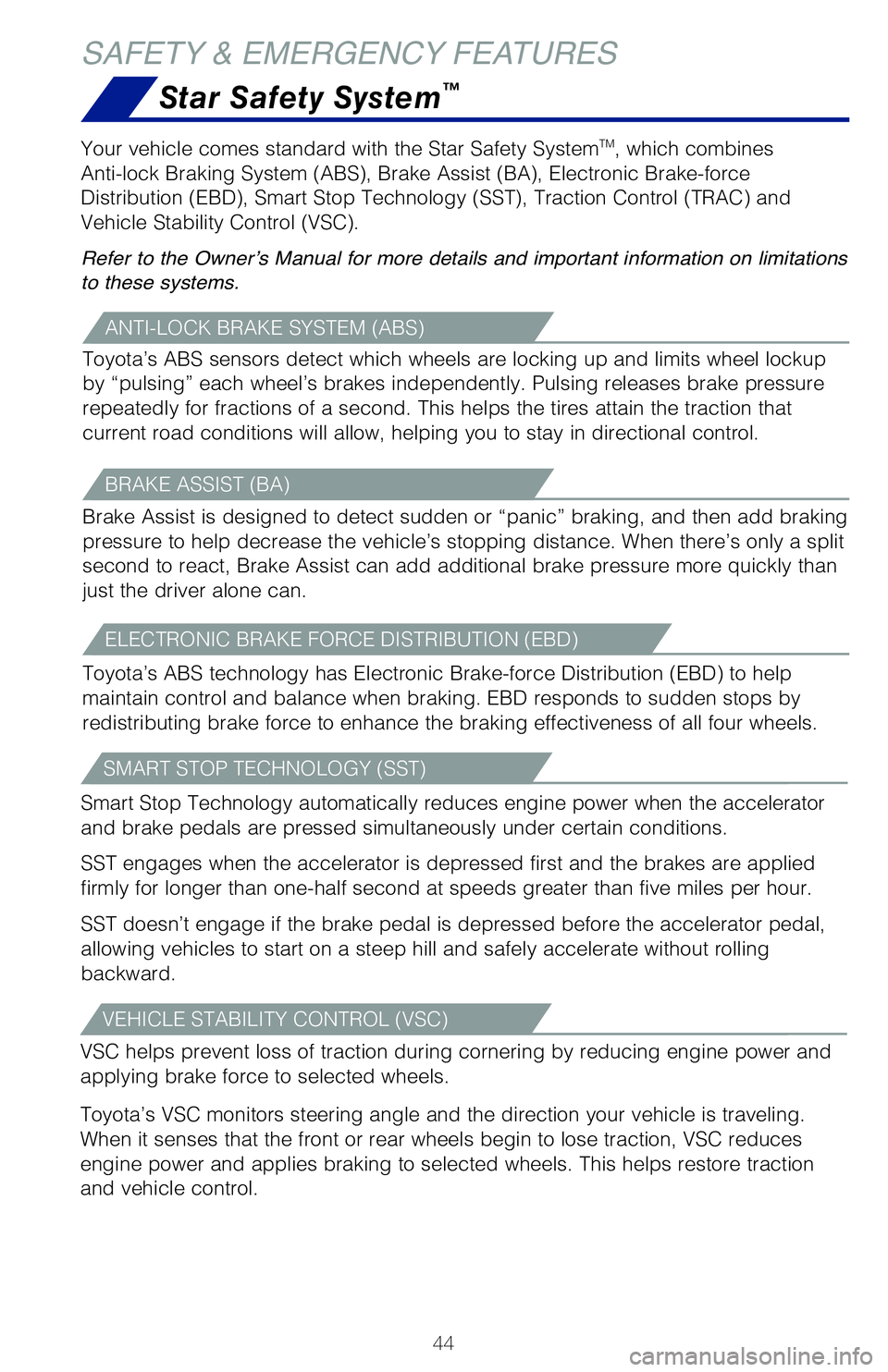
44
There are two types of Toyota floor mats: carpeted and all-weather. Each\
vehicle
has model-specific floor mats. Installation is easy.
To keep your floor mat properly positioned, follow these steps:
• Only use Toyota floor mats designed for your specific model.
• Use only one floor mat at a time, using the retaining hooks to keep\
the mat in place.
• Install floor mats right side up. Trailer sway may occur when towing a trailer due to strong crosswinds, u\
neven and/
or winding road conditions or the driver’s steering input.
Trailer Sway Control uses sensors to detect trailer sway and then simult\
aneously
and automatically helps to suppress the swaying motion of the trailer by\
integrating
brake and engine torque control to reduce speed and to help quickly cont\
rol the
swaying motion of the trailer.
TRACTION CONTROL (TRAC)
VSC helps prevent loss of traction during cornering by reducing engine p\
ower, and
Traction Control helps maintain traction on loose gravel and wet, icy, o\
r uneven
surfaces by applying brake force to the spinning wheel(s).
Toyota’s TRAC sensors are activated when one of the drive wheels star\
ts to slip.
TRAC limits engine output and applies the brakes to the spinning wheel. \
This
transfers power to the wheels that still have traction to help keep you \
on track.
SAFETY & EMERGENCY FEATURES
Star Safety System
™
ANTI-LOCK BRAKE SYSTEM (ABS)
Toyota’s ABS sensors detect which wheels are locking up and limits wh\
eel lockup
by “pulsing” each wheel’s brakes independently. Pulsing release\
s brake pressure
repeatedly for fractions of a second. This helps the tires attain the tr\
action that
current road conditions will allow, helping you to stay in directional c\
ontrol.
BRAKE ASSIST (BA)
Brake Assist is designed to detect sudden or “panic” braking, and \
then add braking
pressure to help decrease the vehicle’s stopping distance. When there\
’s only a split
second to react, Brake Assist can add additional brake pressure more qui\
ckly than
just the driver alone can.
ELECTRONIC BRAKE FORCE DISTRIBUTION (EBD)
Toyota’s ABS technology has Electronic Brake-force Distribution (EBD\
) to help
maintain control and balance when braking. EBD responds to sudden stops \
by
redistributing brake force to enhance the braking effectiveness of all f\
our wheels.
Your vehicle comes standard with the Star Safety System
TM, which combines
Anti-lock Braking System (ABS), Brake Assist (BA), Electronic Brake-\
force
Distribution (EBD), Smart Stop Technology (SST), Traction Control (\
TRAC) and
Vehicle Stability Control (VSC).
Refer to the Owner’s Manual for more details and important information on limitations
to these systems.
SMART STOP TECHNOLOGY (SST)
Smart Stop Technology automatically reduces engine power when the accele\
rator
and brake pedals are pressed simultaneously under certain conditions.
SST engages when the accelerator is depressed first and the brakes are a\
pplied
firmly for longer than one-half second at speeds greater than five miles\
per hour.
SST doesn’t engage if the brake pedal is depressed before the acceler\
ator pedal,
allowing vehicles to start on a steep hill and safely accelerate without\
rolling
backward.
VEHICLE STABILITY CONTROL (VSC)
VSC helps prevent loss of traction during cornering by reducing engine p\
ower and
applying brake force to selected wheels.
Toyota’s VSC monitors steering angle and the direction your vehicle i\
s traveling.
When it senses that the front or rear wheels begin to lose traction, VSC\
reduces
engine power and applies braking to selected wheels. This helps restore \
traction
and vehicle control.
MY21_Tundra_QRG_V2_ML_0709.indd 447/13/20 10:54 AM
Page 47 of 52
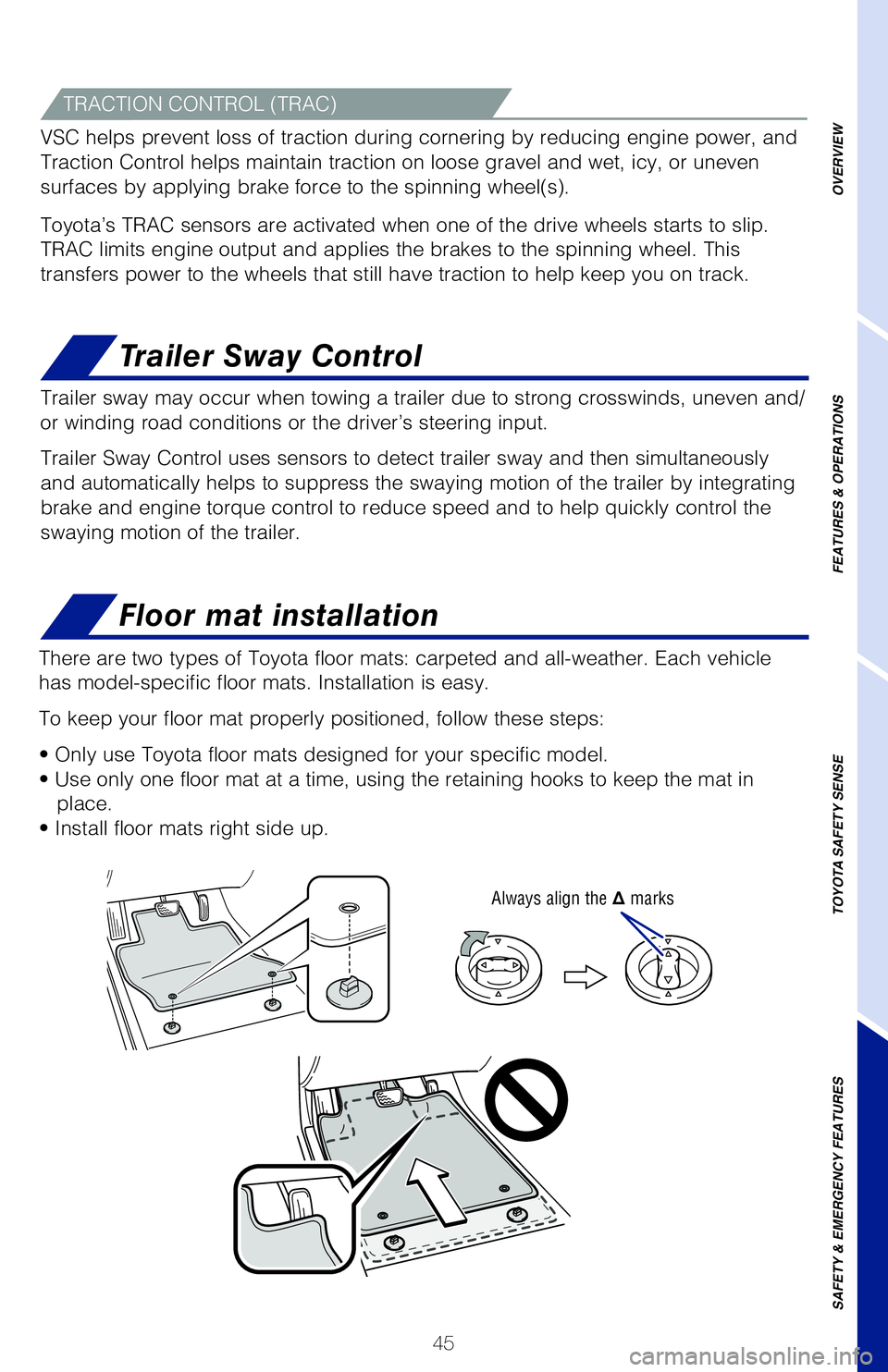
45
Floor mat installation
Trailer Sway Control
There are two types of Toyota floor mats: carpeted and all-weather. Each\
vehicle
has model-specific floor mats. Installation is easy.
To keep your floor mat properly positioned, follow these steps:
• Only use Toyota floor mats designed for your specific model.
• Use only one floor mat at a time, using the retaining hooks to keep\
the mat in place.
• Install floor mats right side up.
Always align the marks
Trailer sway may occur when towing a trailer due to strong crosswinds, u\
neven and/
or winding road conditions or the driver’s steering input.
Trailer Sway Control uses sensors to detect trailer sway and then simult\
aneously
and automatically helps to suppress the swaying motion of the trailer by\
integrating
brake and engine torque control to reduce speed and to help quickly cont\
rol the
swaying motion of the trailer.
TRACTION CONTROL (TRAC)
VSC helps prevent loss of traction during cornering by reducing engine p\
ower, and
Traction Control helps maintain traction on loose gravel and wet, icy, o\
r uneven
surfaces by applying brake force to the spinning wheel(s).
Toyota’s TRAC sensors are activated when one of the drive wheels star\
ts to slip.
TRAC limits engine output and applies the brakes to the spinning wheel. \
This
transfers power to the wheels that still have traction to help keep you \
on track.
OVERVIEW
FEATURES & OPERATIONS
TOYOTA SAFETY SENSE
SAFETY & EMERGENCY FEATURES
Star Safety System™
Toyota’s ABS sensors detect which wheels are locking up and limits wh\
eel lockup
by “pulsing” each wheel’s brakes independently. Pulsing release\
s brake pressure
repeatedly for fractions of a second. This helps the tires attain the tr\
action that
current road conditions will allow, helping you to stay in directional c\
ontrol.
Brake Assist is designed to detect sudden or “panic” braking, and \
then add braking
pressure to help decrease the vehicle’s stopping distance. When there\
’s only a split
second to react, Brake Assist can add additional brake pressure more qui\
ckly than
just the driver alone can.
Toyota’s ABS technology has Electronic Brake-force Distribution (EBD\
) to help
maintain control and balance when braking. EBD responds to sudden stops \
by
redistributing brake force to enhance the braking effectiveness of all f\
our wheels.
Your vehicle comes standard with the Star Safety System
TM, which combines
Anti-lock Braking System (ABS), Brake Assist (BA), Electronic Brake-\
force
Distribution (EBD), Smart Stop Technology (SST), Traction Control (\
TRAC) and
Vehicle Stability Control (VSC).
Refer to the Owner’s Manual for more details and important information on limitations
to these systems.
Smart Stop Technology automatically reduces engine power when the accele\
rator
and brake pedals are pressed simultaneously under certain conditions.
SST engages when the accelerator is depressed first and the brakes are a\
pplied
firmly for longer than one-half second at speeds greater than five miles\
per hour.
SST doesn’t engage if the brake pedal is depressed before the acceler\
ator pedal,
allowing vehicles to start on a steep hill and safely accelerate without\
rolling
backward.
VSC helps prevent loss of traction during cornering by reducing engine p\
ower and
applying brake force to selected wheels.
Toyota’s VSC monitors steering angle and the direction your vehicle i\
s traveling.
When it senses that the front or rear wheels begin to lose traction, VSC\
reduces
engine power and applies braking to selected wheels. This helps restore \
traction
and vehicle control.
MY21_Tundra_QRG_V2_ML_0709.indd 457/13/20 10:54 AM
Page 51 of 52

INDEX
Engine maintenance 8
Fuel tank door release & cap 7
Hood release 8
Indicator symbols 4-5
Instrument cluster 4
Instrument panel 2-3
Instrument panel light control 8
Keyless entry
1 6
Smart Key system1,2 7
OVERVIEW
FEATURES & OPERATIONS
Air conditioning/heating 18
Audio 20
Auto lock/unlock
1 9
Automatic transmission 10
Bottle holders 29
Blind Spot Monitor with Rear
Cross Traffic Alert (BSM w/RCTA) 26
Cup holders 29
Door locks 11
Garage door opener (HomeLink
®)3 28
Headlight leveling dial 13
Heated/ventilated seats 19
Intuitive parking assist 27
Lights
1 & turn signals 12
Mirrors-Power outside rear view 9
Moonroof 14
Multi-Information Display (MID)
2 21
Parking brake 14
Power back window 15
Power outlets-12V DC 22
Power windows 15
Rear seats-Folding 17
Rear view monitor system 19
Seat adjustments-Front 16-17
Seats-Head restraints 17
Steering lock release 14
Steering wheel switches &
telephone controls (Bluetooth
®) 23
TUNDRA 2021
This Quick Reference Guide is a summary of basic vehicle
operations. It contains brief descriptions of fundamental
operations so you can locate and use the vehicle’s main
equipment quickly and easily.
The Quick Reference Guide is not intended as a substitute for
the Owner’s Manual located in your vehicle’s glove box. We
strongly encourage you to review the Owner’s Manual and
supplementary manuals so you will have a better understanding
of your vehicle’s capabilities and limitations.
Your dealership and the entire staff of Toyota Motor North
America, Inc. wish you many years of satisfied driving in your
new Tundra.
A word about safe vehicle operations
This Quick Reference Guide is not a full description of Tundra operation\
s.
Every Tundra owner should review the Owner’s Manual that accompanies \
this
vehicle.
Pay special attention to the boxed information highlighted in color throughout
the Owner’s Manual. Each box contains safe operating instructions to \
help you
avoid injury or equipment malfunction.
All information in this Quick Reference Guide is current at the time of \
printing.
Toyota reserves the right to make changes at any time without notice.
1 Visit your Toyota dealer for information on customizing this feature.2 Programmable by customer. Refer to the Owner’s Manual for instruction\
s and more information.3 HomeLink® is a registered trademark of Gentex Corporation.
MY21_Tundra_QRG_V2_ML_0709.indd 62437/13/20 10:54 AM
Enable Notifications (text
message). While pairing your
phone, a message will be
displayed:
"You may need to allow
message access on your
phone."
Note: You may also select
"Skip" on display screen to skip
enabling notifications. If skipped,
proceed to Step 8.
A confirmation will appear once
your phone has been paired and
connected.
49
NOTES
MY21_Tundra_QRG_V2_ML_0709.indd 497/13/20 10:54 AM20-MKG-14820MY21 Toyota Tundra QRG .indd 27/13/20 11:04 AMUntitled-1 47/13/20 11:58 AM